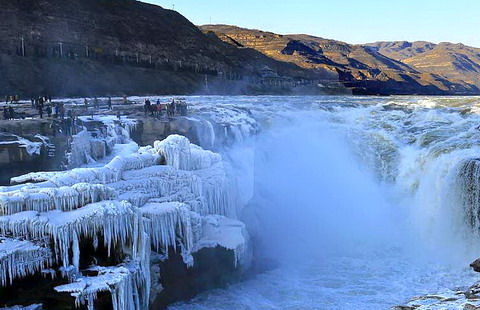Call of the ganges
Updated: 2015-02-09 07:47
By Yang Feiyue and Satarupa Bhattacharjya(China Daily)
|
||||||||
India needs to promote its tourism resources better among Chinese travelers to get them to visit, Yang Feiyue and Satarupa Bhattacharjya report.
Li Si, 25, packed a few boxes of instant noodles on his first trip to India in 2011. The Beijing resident was worried that the local food wouldn't suit him. Many foreign tourists to India appear to fear the "Delhi belly", or traveler's diarrhea, a term that even visiting expatriate Indians tend to use.
But as it turned out, Li's nine-day tour wasn't just easy on the stomach but also on his eyes.
He travels through northern India included seeing Mughal-era fortresses and mausoleums such as Red Fort in capital New Delhi and Taj Mahal in Agra city. In white marble, the Taj is considered an ancient world wonder like the Great Wall, and is the top-most tourist attraction for Chinese as is the Wall for Indians.
"India was much better than I had expected it would be," Li tells China Daily. "I enjoyed the food very much."
While Li's visit helped to change his perception of that country, analysts say that there are many more Chinese travelers who aren't aware of India's abundant tourism resources, which is a key reason for the Chinese tourists' underdeveloped interest in India.
A total of 645,600 Indians visited China from January to November 2014, up 3.6 percent year-on-year as compared with the year before, while 124,600 Chinese made trips to India, down 4.23 percent during the same period, according to data from the China National Tourism Administration.
The Indian tourism office in Beijing gave 174,712 as the number of Chinese that visited India in 2013.
"Although China and India are neighbors, there haven't been many non-government exchanges, and India didn't launch enough major promotional events in China (in the past) to boost its national image, which is very important," says Liu Zhiming, chief analyst for National Public Opinion Poll, a Chinese tourism think-tank.
Many Chinese have been associating that country with "poverty and chaotic and filthy streets", according to him.
India, Asia's third-largest economy, has traditionally seen a healthy inflow of Western tourists, drawn to its local cuisines, folk heritage, rich history and ancient civilization sites, but still it has had to fight stereotypical imaging such as being "a land of snake charmers" long after its info-tech business had boomed.
But a boost in Indo-China tourism could now come from the slew of initiatives that both governments have promised.
India's foreign minister Sushma Swaraj launched the "Visit India Year 2015" campaign in Beijing on Feb 2, when Indian Prime Minister Narendra Modi welcomed Chinese tourists to his country through a video message in Hindi, with some words in Chinese.
China will publicize India's tourism resources and support airline companies to have more flights to India from Chinese cities and reduce airfares, Chinese vice-premier Wang Yang said at the same unveiling ceremony. He hoped that India would facilitate visa application processes for Chinese tourists and offer more quality tourism services.
Some Chinese grumble about visa delays.
Barring the Taj, the river Ganges and the city of Jaipur are the other main Indian attractions for Chinese, says Jean Wong, a product manager at HHtravel, a luxury travel brand under the major Chinese online travel agency Ctrip.
From the banks of the Ganges that flows through the heart of India, tourists can experience the nightly ritual of lit earthen lamps floating along the river. And for wildlife enthusiasts, the eastern Indian sanctuary of Sunderbans, where Royal Bengal tigers can be sighted is a hot destination, she adds.
The travel agency has seen some rise in the number of Chinese tourists to India in the past few years, but the overall demand isn't big as compared with China's other neighbors such as Japan and South Korea. Indian tourism officials say it is probably owing to greater cultural similarities among Southeast Asian nations.
Beijing and New Delhi are just six hours apart by direct flights.
"Our guests have also shown concerns over local health and social environment," says Wong of Chinese tourists to India.
Foreign tourists complain about public sanitation issues in India and consider some parts of India unsafe for women travelers. But according to Indian government officials, major steps are being taken toward greater cleanliness in cities and to ensure women's safety.
"We need to take up more promotional activities to create a favorable brand image in China," says Deepa Laskar, the director of India Tourism Office in Beijing. She points to the many road shows and exhibitions that were held across China as part of the "Incredible India" program. China also witnessed a yearlong "Glimpses of India" cultural festival in 2014.
China is expected to host the "Visit China Year 2016" program in India.
"China will actively develop special tourism products to satisfy Indian people's needs for sightseeing, vacation, medical and sports activities, and help India develop Chinese tour guides and eateries," Li Jinzao, director general of the China National Tourism Administration, said at the "Visit India 2015" ceremony.
Contact the writers at yangfeiyue@chinadaily.com.cn and satarupa@chinadaily.com.cn
(China Daily 02/09/2015 page24)
- Asian American employment data are now seasonally adjusted
- China seeks compensation from Mexico after high-speed project suspended
- Brazil in 'eclipse', China 'shines': Expert
- China to build two nuclear power plants in Argentina
- Sri Lanka in U-turn on port project
- Russia expresses optimism about solution to Ukraine issue
Most Viewed
Editor's Picks

|

|

|

|

|

|
Today's Top News
Venezuela's economic woes to continue: Panel
China seeks compensation from Mexico after high-speed project suspended
China to build two nuclear power plants in Argentina
Xi plans to make state visit to US
Trade numbers take big hit in January
Search continues for 3 missing in TransAsia crash
Beautiful girl loses battle with cancer
Three more H7N9 cases reported in China's Guangdong
US Weekly

|

|















